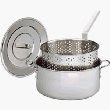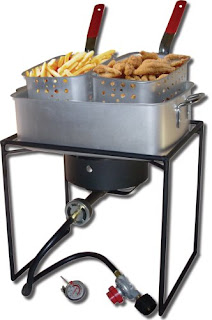Постинг
09.03.2010 00:11 -
Frying pans
Автор: domigradina
Категория: Други

Прочетен: 1588 Коментари: 0 Гласове:
Последна промяна: 09.03.2010 00:12

Прочетен: 1588 Коментари: 0 Гласове:
0
Последна промяна: 09.03.2010 00:12
Frying pans
Copper frying pans were used in ancient Mesopotamia. Frying pans were also known in ancient Greece (where they were called tйganon) and Rome (where they were called patella or sartaginem).

The frying pan remained little changed for many years. Whether made of tinned copper or cast iron the frying pan had a broad, shallow body and a long handle to keep the cook’s hand out of the fire.
[edit] Etymology
Pan derives from the Old English panna.[1] The feature that distinguished pans from other utensils were their flat bottoms. (This is why sauce pans and sautй pans, while very different in shape, are nonetheless called "pans").
The first recorded usage of the term frying pan in English was in 1382 by John Wyclif in a translation of the Vulgate Bible, 1 Chronicles 23:29: "The prestis..to the fryinge panne." The term fry pan rarely occurs before the 1950s, when electric fry pans rose in popularity. When it does, it is often as the double fry or omelette pan. Frying pans with legs, once common in open hearth cookery, were generally called spiders both in England and in America.
pans with legs, once common in open hearth cookery, were generally called spiders both in England and in America.
Skillets were originally deep, much like modern sauce pans, but the term is now used interchangeably with "frying pan."
The Roman term, sartaginem has survived in modern Spanish as sartйn, and in modern Portuguese as sertг। The Roman patella survived in modern Italian as padella, in modern Spanish as paella, and in modern French as poкle. Frying pans were probably also used to prepare grain dishes, the antecedents of paella made with rice.
Frying pan relatives
A versatile pan that combines the best of both the sautй pan and the frying pan has higher, sloping sides that are often slightly curved. This pan is called a sauteuse (literally a sautй pan in the female gender), an evasйe (denoting a pan with sloping sides), or a fait-tout (literally "does everything"). Most professional kitchens have several of these utensils in varying sizes.
Another close relative is the chafing dish, which by the late nineteenth century was a pot or pan that sat in a lower pan of hot water. Both chafing dishes and frying pans were supported by a stand over a flame below. The heat maintained the water at a simmer, which allowed for the slow cooking of foods like soups and fondues.
Copper frying pans were used in ancient Mesopotamia. Frying pans were also known in ancient Greece (where they were called tйganon) and Rome (where they were called patella or sartaginem).

The frying pan remained little changed for many years. Whether made of tinned copper or cast iron the frying pan had a broad, shallow body and a long handle to keep the cook’s hand out of the fire.
[edit] Etymology
Pan derives from the Old English panna.[1] The feature that distinguished pans from other utensils were their flat bottoms. (This is why sauce pans and sautй pans, while very different in shape, are nonetheless called "pans").
The first recorded usage of the term frying pan in English was in 1382 by John Wyclif in a translation of the Vulgate Bible, 1 Chronicles 23:29: "The prestis..to the fryinge panne." The term fry pan rarely occurs before the 1950s, when electric fry pans rose in popularity. When it does, it is often as the double fry or omelette pan. Frying
 pans with legs, once common in open hearth cookery, were generally called spiders both in England and in America.
pans with legs, once common in open hearth cookery, were generally called spiders both in England and in America.Skillets were originally deep, much like modern sauce pans, but the term is now used interchangeably with "frying pan."
The Roman term, sartaginem has survived in modern Spanish as sartйn, and in modern Portuguese as sertг। The Roman patella survived in modern Italian as padella, in modern Spanish as paella, and in modern French as poкle. Frying pans were probably also used to prepare grain dishes, the antecedents of paella made with rice.
Frying pan relatives
A versatile pan that combines the best of both the sautй pan and the frying pan has higher, sloping sides that are often slightly curved. This pan is called a sauteuse (literally a sautй pan in the female gender), an evasйe (denoting a pan with sloping sides), or a fait-tout (literally "does everything"). Most professional kitchens have several of these utensils in varying sizes.
Another close relative is the chafing dish, which by the late nineteenth century was a pot or pan that sat in a lower pan of hot water. Both chafing dishes and frying pans were supported by a stand over a flame below. The heat maintained the water at a simmer, which allowed for the slow cooking of foods like soups and fondues.
Няма коментари
Търсене
За този блог

Гласове: 216
Блогрол
1. selsko stopanstvo
2. riba
3. diving02-20
4. watches for you
5. gardener07-20
6. dom i gradina
7. diving sky
8. home
9. watches for you
10. gardens and home
2. riba
3. diving02-20
4. watches for you
5. gardener07-20
6. dom i gradina
7. diving sky
8. home
9. watches for you
10. gardens and home
